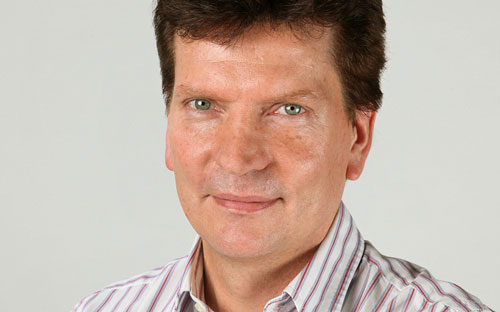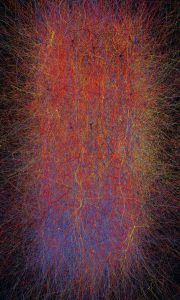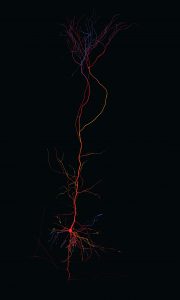
The Blue Brain Project is an attempt to simulate the human brain using supercomputers to allow neuroscientists, biologists, physicists and computer scientists to better understand the brain and to provide them with the tools to simulate diseases and, hopefully, come closer to alleviating them.
SA expat, former Fulbright Scholar and University of Cape Town alumnus Henry Markram is the director of the Blue Brain Project at École Polytechnique Fédérale de Lausanne (EPFL) in Switzerland. He says the project is meant to simulate the activity of the brain using supercomputers, a process he hopes will provide a more holistic understanding of the brain.
Markram says the project is essentially one of reverse engineering but, instead of a gadget, the object is a mammalian brain. Originally the project set out to simulate the 10 000 neurons of a rat’s neocortical column. Markram completed that project successfully in 2005 and has since been working on the longer term goal of simulating the human brain.

“As part of the project, we are teaching 30 or so of the best students we could find across Africa,” says Markram, who is in SA this month. The students come from a range of faculties and the project will see five of them participating in exchange programmes with European universities.
The Blue Brain project involves technical collaboration with IBM and EPFL buys its supercomputers from the company. It employs IBM’s Blue Gene supercomputer technology and is funded by the Swiss government.
Markram says there is far more to the project than merely simulating the brain’s functions. Another key aim is creating “medical infomatics” using data and statistics from hospitals around the world to improve the simulations and better diagnose individuals suffering from brain disorders or diseases.
There is also the hope that the Blue Brain Project, and an interrelated project called the Human Brain Project, will help in the development of new supercomputer technology that Markram calls “neuromorphic technology”.
“’Neuromorphic’ basically refers to a new kind of processor based on how the brain handles information and calculations as opposed to the way processors do traditionally,” he says. Work is also underway with related robotics developments and the creation of “neuroprosthetic devices”.
Markram says one of the biggest challenges facing neuroscientists is coming to grips with disease, and that part of the problem is that studies of the brain — and the diseases that ail it — are fragmented because of the need for enormous specialisation.
“There are many specialists, but there’s no coherent or integrated view,” he says. “It’s like a gold rush with people digging into small corners but no bigger picture. We can’t tell what one gene or protein does in the context of whole brain.”
When people look for genes causing diseases they find that in the brain, unlike the rest of the body, there isn’t one, or even 10, but rather hundreds of genes that all play some role in a single disease. “We need to understand how [the genes] all interact together and orchestrate a disease. That can’t be done in one lab, because individually labs are too specialist.”

The University of Cape Town is halfway through a two-week school that Markram is leading to link Africa, and particularly SA, with the Blue Brain and Human Brain projects. It involves scientists from 22 faculties and students from across Africa.
Eight of the students are from SA, with the rest coming from places like Cameroon, Egypt, Nigeria and Tanzania. Markram says there were more than 300 applications, of which around 30 made the final selection. The students include physicists, neuroscientists, behavioural neuroscientists, computer scientists and biologists.
The main supercomputer employed by the Blue Brain Project has more than 16 000 processor cores, but the next one to be installed will have 100 000, and within the next 10 years that will be replaced by a €300-500m IBM “exascale supercomputer” capable of more than a billion billion floating point operations per second (an exaflop).
“We want to get ready for such a machine and we have to start training students now to be able to use a machine like that,” Markram says.
Ultimately, much of the Human Brain and Blue Brain projects concern reverse engineering. Markram says it’s hoped the teams working on them will figure out both how many neurons there are in the brain, and what types of neurons.
“We suspect there are a few thousand types. So, we develop methods that look for the different genes that are switched on to build different cells. It’s more complicated in the brain than in other organs because there are more genes building more kinds of cells.”
He says that once it’s known how genes build different types of cells, equations can be constructed to mimic this process. “We have to work out the distribution. Like a good pasta recipe, we need to know how many of each different neuron to put in.”
Then scientists need to figure out how these neurons are connected. Markram says using supercomputers, infomatics and modelling it’s possible to work out where these connections need to be.
He says the process can be thought of as an enormous audit. “The advantage of the audit approach is you see big holes quickly and can often fill them without experiments by extrapolation. We then test them to see if they’re valid.”
In due course Markram expects scientists will be able to “systematically deconstruct” the brain into its parts. “It’s a big problem, but not an infinite one.” — Craig Wilson, TechCentral
- Subscribe to our free daily newsletter
- Follow us on Twitter or on Google+ or on Facebook
- Visit our sister website, SportsCentral (still in beta)




